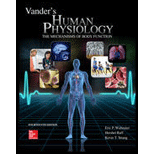
Vander's Human Physiology
14th Edition
ISBN: 9781259294099
Author: Eric P. Widmaier Dr., Hershel Raff, Kevin T. Strang Dr.
Publisher: McGraw-Hill Education
expand_more
expand_more
format_list_bulleted
Concept explainers
Question
Chapter 9, Problem A.6RQ
Summary Introduction
To define: Motor unit and describe its structure.
Introduction: In an adult, 40 to 50% body weight is contributed by skeletal muscles. The primary cells that form a skeletal muscle is the skeletal muscle fibers. They perform functions such as body movement, posture maintenance, support and protection, heat production, and regulating elimination of materials.
Expert Solution & Answer
Want to see the full answer?
Check out a sample textbook solution
Chapter 9 Solutions
Vander's Human Physiology
Ch. 9 - Prob. 1PICh. 9 - Prob. 2PICh. 9 - If the ACh receptor channel is equally permeable...Ch. 9 - Prob. 4PICh. 9 - Prob. 5PICh. 9 - Under certain experimental conditions, it is...Ch. 9 -
Figure 9.16 (a) Measurement of tension during a...Ch. 9 - Prob. 8PICh. 9 - Prob. 9PICh. 9 - Prob. 10PI
Ch. 9 - Prob. 11PICh. 9 - Prob. 12PICh. 9 - Prob. 13PICh. 9 - List the three types of muscle cells and their...Ch. 9 - Prob. A.2RQCh. 9 - Describe the organization of myosin, actin,...Ch. 9 - Prob. A.4RQCh. 9 - Describe the structure and function of the...Ch. 9 - Define motor unit and describe its structure.
Ch. 9 - Describe the sequence of events by which an action...Ch. 9 - What is an end-plate potential, and what ions...Ch. 9 - Prob. A.9RQCh. 9 - What prevents cross-bridges from attaching to...Ch. 9 - Prob. A.11RQCh. 9 - Prob. A.12RQCh. 9 - Prob. A.13RQCh. 9 - Prob. A.14RQCh. 9 - Prob. A.15RQCh. 9 - Describe isometric, concentric, and eccentric...Ch. 9 - Prob. A.17RQCh. 9 - Prob. A.18RQCh. 9 - Prob. A.19RQCh. 9 - Prob. A.20RQCh. 9 - Prob. A.21RQCh. 9 - What fuel molecules are metabolized to produce ATP...Ch. 9 - Prob. A.23RQCh. 9 - What component of skeletal muscle fibers accounts...Ch. 9 - Summarize the characteristics of the three types...Ch. 9 - Prob. A.26RQCh. 9 - Prob. A.27RQCh. 9 - Prob. A.28RQCh. 9 - Prob. A.29RQCh. 9 - Prob. A.30RQCh. 9 - Prob. A.31RQCh. 9 - Prob. A.32RQCh. 9 - Prob. 14PICh. 9 - Prob. B.1RQCh. 9 - Prob. B.2RQCh. 9 - Prob. B.3RQCh. 9 - Prob. B.4RQCh. 9 - Prob. B.5RQCh. 9 - Prob. B.6RQCh. 9 - Prob. B.7RQCh. 9 - Prob. B.8RQCh. 9 - Prob. B.9RQCh. 9 - Explain why cardiac muscle cannot undergo tetanic...Ch. 9 - Prob. 1RRCh. 9 - Prob. 2RRCh. 9 - Prob. 1RCCh. 9 - Prob. 2RCCh. 9 - Prob. 3RCCh. 9 - Prob. 4RCCh. 9 - Prob. 5RCCh. 9 - Prob. 6RCCh. 9 - Prob. 7RCCh. 9 - Prob. 8RCCh. 9 - Prob. 9RCCh. 9 - Prob. 10RCCh. 9 - Prob. 11RCCh. 9 - Prob. 1AAECh. 9 - Prob. 2AAECh. 9 - Prob. 3AAECh. 9 - Prob. 4AAECh. 9 - Prob. 5AAECh. 9 - Prob. 6AAECh. 9 - Prob. 7AAECh. 9 - Prob. 8AAECh. 9 -
If a single twitch of a skeletal muscle fiber...Ch. 9 - Prob. 1GPACh. 9 - Prob. 2GPACh. 9 - Prob. 3GPA
Knowledge Booster
Learn more about
Need a deep-dive on the concept behind this application? Look no further. Learn more about this topic, biology and related others by exploring similar questions and additional content below.Types of Human Body Tissue; Author: MooMooMath and Science;https://www.youtube.com/watch?v=O0ZvbPak4ck;License: Standard YouTube License, CC-BY